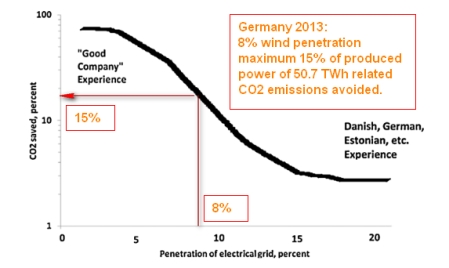The problem of how much wind turbines for electricity production decrease CO2 emissions when they replace existing fossil fuel power stations is a crucial one. Usually the political decision to push wind power electricity is the underlying assumption that climate hurting CO2 emissions will be diminished. Hubert Inhaber has published a paper in the Elsevier Journal “Renewable and Sustainable Energy Reviews”, vol 15, issue 6 (August 2011) with the title “Why wind power does not deliver the expected emissions reductions”. This paper is a meta-analysis of other papers on that subject, and also an analysis of existing wind power installations; here Denmark and Germany certainly are the principal players (in 2013 Danish wind power delivered 35% of its total electricity production, and the German percentage was 8%). Actually the findings seem valid for all intermittent electricity producers, including solar PV.
The media and lobbies usually tell that x kWh produced by a wind turbine correspond to an avoidance of the same number times the CO2 intensity, e.g. x*850 g CO2 when electricity is produced by a classical coal power station. This naive assumptions neglects the intermittency, clearly the Achilles heel of wind and solar power. Weather conditions may plunge these intermittent producers close to zero, as shown in the following picture (link).
The needed power at the end of the day was greater than 50000 MW, which means that fossil fuel (probably not nuclear generators) had to be ramped up to ensure grid reliability. This non-intermittent backups completely change the picture, as they must increase with a higher penetration of wind and solar power stations. Inhaber shows a nice curve (attention: left scale is logarithmic!) based on German and other countries data which gives the percentage in CO2 avoidance versus the penetration of wind power (penetration = percentage of wind power electricity w.r. to total electricity produced), assuming grid stability must be maintained.
 Germany’s wind turbines produced 8% of a total of 634 TWh in 2013, i.e. 50.7 TWh. Let us assume that the electricity mix emits 552 g CO2 per kWh (see here). If no wind turbines had been installed, the 50.7 TWh produced by classical means would have emitted 50.7*1E9[kWh]*0.552*1E-3[ton] = 28 million metric tons of CO2. With the installed wind turbines, these emissions become 24 million tons of CO2, with an unspectacular avoidance of only 4 million tons (all numbers rounded). Should intermittent wind (and solar) power reach 20% penetration, the CO2 avoidance falls to an abysmal 2% !
Germany’s wind turbines produced 8% of a total of 634 TWh in 2013, i.e. 50.7 TWh. Let us assume that the electricity mix emits 552 g CO2 per kWh (see here). If no wind turbines had been installed, the 50.7 TWh produced by classical means would have emitted 50.7*1E9[kWh]*0.552*1E-3[ton] = 28 million metric tons of CO2. With the installed wind turbines, these emissions become 24 million tons of CO2, with an unspectacular avoidance of only 4 million tons (all numbers rounded). Should intermittent wind (and solar) power reach 20% penetration, the CO2 avoidance falls to an abysmal 2% !
Inhaber suggests (with caveats!) the following equation for the above curve:
CO2_avoidance% = 200/(1 + exp(0.2*penetration%))
which tends asymptotically to zero with increasing penetration.
A second effect of increasing intermittent renewables is a dramatic plunge in the capacity factors, as shown in this picture adapted from the Power Magazine:
Germany has an impressive 45% of combined wind and solar capacity installed, but has the lowest capacity factor ( = percentage of delivered versus theoretical maximum power) of the 10 countries (the capacity factors are given in the red boxes). These numbers simply tell us that if a certain volume of electricity must be produced, the number of renewable power stations must exceed more and more the number suggested by their name plate capacity.
These are truly gruesome numbers, which make a mockery of the (naive?) enthusiasm of those that think that intermittent emission free producers like wind and solar may de-carbonize a future non-nuclear electricity production.
A discussion from Australia on this problem can be found here and a very interesting report in Biospherica here. Read also this paper by Fred Udo using Eiregrid production data (not models!) show that “the introduction of wind energy without buffer storage leads to increased fossil fuel use and CO2 emissions and is a non-sustainable practice. ”
The Eiregrid engineers wrote in a 2004 report Impact of Wind Power Generation that “It is not sufficient to estimate the amount of energy which can be obtained from a given capacity of WPG, and to assume that the equivalent percentage of fossil fuel and therefore CO2 can be avoided. This ignores the impact of the increasing number of start-ups and lower capacity factor as WPG increases.” They give 2 scenarios: when wind capacity is 1500 MW, the CO2 reduction is 470 ton/MWh: with 3500 MW capacity, the reduction is only 331 ton/MWh ; there is a diminishing return of CO2 avoidance with increasing wind power penetration.
_______________________________________________
History:
07 Dec 2014: original version
08 Dec 2014: added lines with links to the Fred Udo paper and Eiregrid report.

